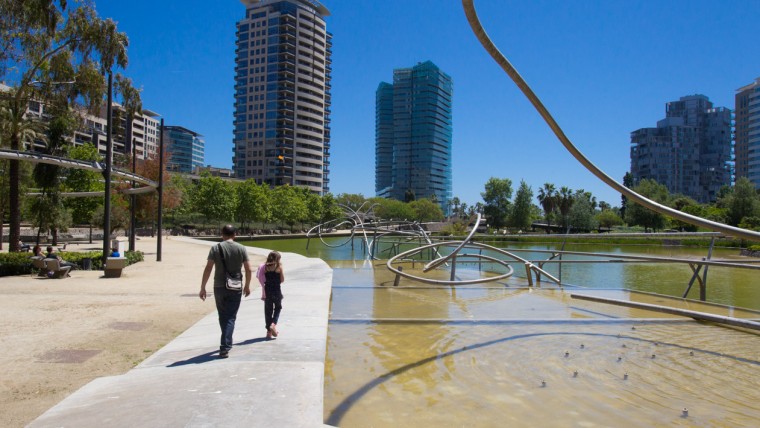
Diagonal Mar Park is spread out according to a design that helps it to blend in with the city through a large, open space that finally links to the sea.
It is built round a series of paths which, like a tree, branch out in every direction. All around there are very long concrete benches, separating and organising spaces, which are intended to conjure up the feeling of sea waves as they progressively adopt the shape of these paths and the contours of several squares.

History
The industrial past of the land now making up Diagonal Mar – the old Macosa smelting plant – had left a no-man’s land. By the end of the last century, Barcelona needed to extend its coastline to enable the city to link up with all the new beaches created during that period. So, with that goal in mind, the then mayor, Joan Clos, laid the first stone for the future on 25 May, 1999, along with a box containing the day’s newspapers, a calendar sheet, deposits and a statement of sustainability signed by the City Council and the building companies that took part in the area’s big urban development project.
It occupies an area of over 340,000 m2, bounded by C/ Llull, C/ Josep Pla and C/ Selva de Mar, Parc Lineal Garcia Fària and the final section of Av Diagonal. It has various uses, offering residential buildings, offices, a shopping centre, hotels and a park.

Art and Architecture
These large metallic structures run down sloping stairs with small jets that spurt out the water which feeds the lake.
Other notable features include the large flowerpots found on the “patios”.
They are inspired by the old neighbourhood patios. These immense flowerpots either hang from high metal pergolas or stand on paving reminiscent of the old tiled floors in these parts.
Another notable feature are the very windy, concrete benches that have been christened “lungomare”, which is what Italians call walking by the sea.
-
- Phone number
- Tel.: 010
-
- Accessibility
- Accessible for people with physical disabilities
-
- Titularity
- Public center
- Address:
- Carrer de Llull, 356 - 360
- Districte:
- Sant Martí
- Neighborhood:
- Diagonal Mar i el Front Marítim del Poblenou
- City:
- Barcelona
Timetable
| Periode | Dies | Hores |
|---|---|---|
Horari d’hivern: de l'1 de novembre al 31 de març |
Cada dia | de 09.30 h a 19.00 h |
Horari d’estiu: de l'1 d'abril al 31 d'octubre |
de 09.30 h a 21.00 h |
- Sections of this equipment
- Àrea de joc infantil Open in a new window
- Àrea de joc infantil Open in a new window
- Àrea de joc infantil Open in a new window
- Cistelles de bàsquet Open in a new window
- Taules de ping-pong Open in a new window
- Camp de futbol Open in a new window
- Pista poliesportiva Open in a new window
- Llac Open in a new window
- Àrea d'esbarjo per a gossos Open in a new window
- Àrea de joc infantil Open in a new window
- Tobogans gegants Open in a new window
- Pistes municipals de petanca Open in a new window

